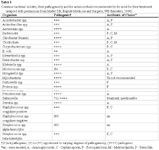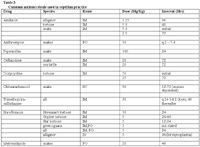Antibiotic therapy in reptiles (Proceedings)
To date there have been very few pharmacokinetic studies published in reptiles, and with only only limited numbers of antibiotics.
To date there have been very few pharmacokinetic studies published in reptiles, and with only only limited numbers of antibiotics. So far, all of the studies have been done in snakes, turtles and crocodilians. There have been no pharmacokinetic studies done in lizards.
There are a number of factors that must be considered when choosing an antibiotic. The results of microbiological culture and sensitivity testing, the species being treated, physical condition of the patient, frequency of administration, cost of the therapy, owner compliance, and a host of other factors are all important.
The veterinary clinician must have a thorough understanding of reptile physiology and biology prior to administering medications. Since all reptiles are ectotherms, and their metabolism is temperature dependent, they will often react unpredictably to the same drug in different settings. A good working knowledge of the more common species of reptiles, their life histories and their peculiarities will help prevent potential disasters during therapy.
General considerations
Before treatment is initiated the patient should be given a thorough exam including a CBC and serum profile, with a uric acid, to assess hydration status. Dehydrated or hyperuricemic patients should be properly rehydrated prior to initiating therapy. It is the rare case that cannot wait one to two days to assure appropriate hydration prior to treatment. However, if for some reason treatment must be instigated immediately, it would behoove the practitioner to choose a non-nephrotoxic drug.

Table 1
Another important consideration is the ambient temperature of the reptile's environment. Pharmacokinetic studies have shown that an increase in ambient temperature tends to increase both the volume of distribution and body clearance of the drug. A decrease in ambient temperature with a resultant decrease in body clearance could potentially allow a build up in concentration of the drug to a point where it might reach toxic levels if dosing is not decreased accordingly.
When reptile pathogens are treated at higher temperatures the Mean Inhibitory Concentration (MIC) needed to achieve effective treatment significantly decreases. This allows for a lower dose of antibiotic to be given, another positive factor when dealing with potentially nephrotoxic drugs.
Most researchers feel that it is best to treat sick reptiles near the higher end of their preferred optimum temperature zone. Not only is it beneficial for reasons already mentioned, but elevated ambient temperatures have been shown to stimulate the host's immune system and aid in fighting disease in other ways already discussed.

Table 2
When selecting the appropriate antibiotic it is important to consider the status of the host's immune system. In critically ill or immuno-compromised reptiles, bactericidal, rather than bacteriostatic antibiotics are preferable. In cases of gram negative sepsis, especially with Pseudomonas infections, the reptile patient is often severely immunocompromised.
In many cases the animals are infirmed because they have been immunocompromised due to improper husbandry conditions. The most common cause is from being maintained at suboptimal environmental temperatures.
Methods of administration
There are very few instances where oral antibiotic therapy is required. Enteric infections often warrant oral administration of appropriate drugs. There are two common methods for administering oral antibiotics. If the patient is still feeding, the antibiotic can be mixed with the food or injected into the dead prey and fed to the animal. Gavaging, or stomach tubing, is a second technique which can be used to administer oral medications.

Table 3
Topical antibiotic therapy
Although oral dosing of systemic antibiotics is not commonly done, it is not uncommon to actually treat the oral cavity itself. This is often done in cases of severe Infectious Stomatitis where the oral cavity is abscessed. Since the vascularity to an abscessed oral cavity is usually compromised, antibiotics given systemically may not be able to reach adequate therapeutic levels in the infected tissues. Aminoglycoside antibiotics have decreased activity in anaerobic or acidic environments. When treating with a drug like enrofloxacin systemically you can also use topical flouroquinolone on the lesions in the oral cavity. Daily application of Ciloxin ® ophthalmic solution, one drop on each affected area, works well.
Silvadene® is a soft, white, water-miscible cream containing the antimicrobial agent silver sulfadiazine. This bactericidal cream is effective against a broad range of both gram positive and gram negative bacteria, including Pseudomonas aeruginosa, as well as some of the yeasts. Silvadene® is easily applied with a cotton tipped swab or other applicator. A dressing is not necessary unless the area being treated is in a location where the cream may be rubbed off. Otherwise, the cream will last for two to three days before a new application is required.
Injectable antibiotic therapy
Injectable antibiotics are probably the best form for assuring proper delivery of the drug. The antibiotics are either injected intramuscularly, or less commonly, subcutaneously. The intravenous route is often limited by the availability of venous access. The size and species being treated will determine whether intravenous infusion is possible.
Reptiles have an anatomical variation called the renal portal system. Blood leaving the tail and pelvic limbs passes through the kidneys before returning to the heart. When administering antibiotics which are either cleared by the kidney or are potentially nephrotoxic, the hind limbs and tail should not be used. Antibiotics excreted from he body via glomerular filtration bypass this renal portal system. Antibiotics that are secreted by the peritubular capillaries are affected and have the potential of a decreased ciruclating concentration if the medications are injected into the rear legs or the tail. The renal portal system can be avoided by making all injections in the cranial half of the body.
An important consideration when selecting an antibiotic is its ability to penetrate the target tissue site. In cases of severe Infectious Stomatitis, the vascular supply may be compromised to the oral cavity in the area of the lesions. This may prevent good penetration of the antibiotic to the site of infection.
Another method of assuring adequate antibiotic levels to the affected tissue is to calculate the total systemic dose, draw it into a syringe, and then add an equal volume of bacteriostatic water to dilute it out to half concentration. Inject three-fourths of the dose intramuscularly, and the remaining quarter dose directly into the region of the mouth where the infection is present. If you need to inject in more than one place in the mouth it is a good idea to switch needles to prevent seeding of bacteria from one site to another.
Fluid therapy
Since reptiles are uricotelic, that is, they excrete uric acid as the end product of protein metabolism, they are readily susceptible to visceral gout. If the patient is dehydrated or develops renal pathology due to treatment with nephrotoxic drugs, the insoluble uric acid forms microcrystals called "tophi" on the serosal surfaces and within tissues such as the heart, lungs, liver and kidneys.
Visceral gout can be prevented by utilizing proper drug dosages, evaluating the patient's hydration status and monitoring blood uric acid levels throughout therapy. A follow-up blood uric acid should be checked one to two weeks after the treatment is finished.
The patient should be supplemented with physiologic fluids at 15-25 ml/kg on the days it receives antibiotic treatment. The fluids can be given orally, intracoelomically, or subcutaneously in the lateral sinus. The latter is located at the junction between the epaxial musculature and the ribs.